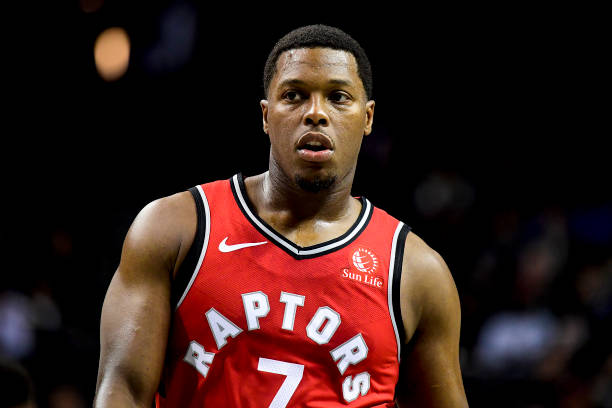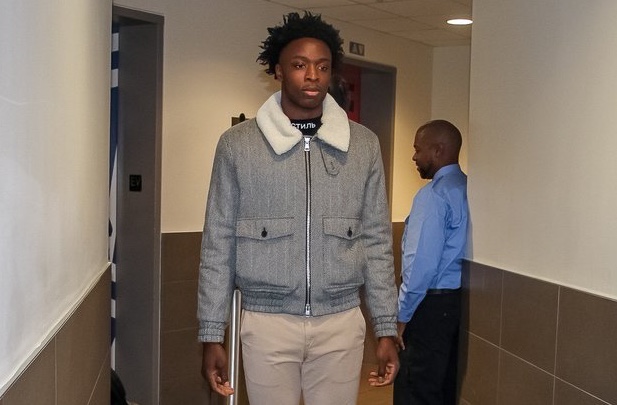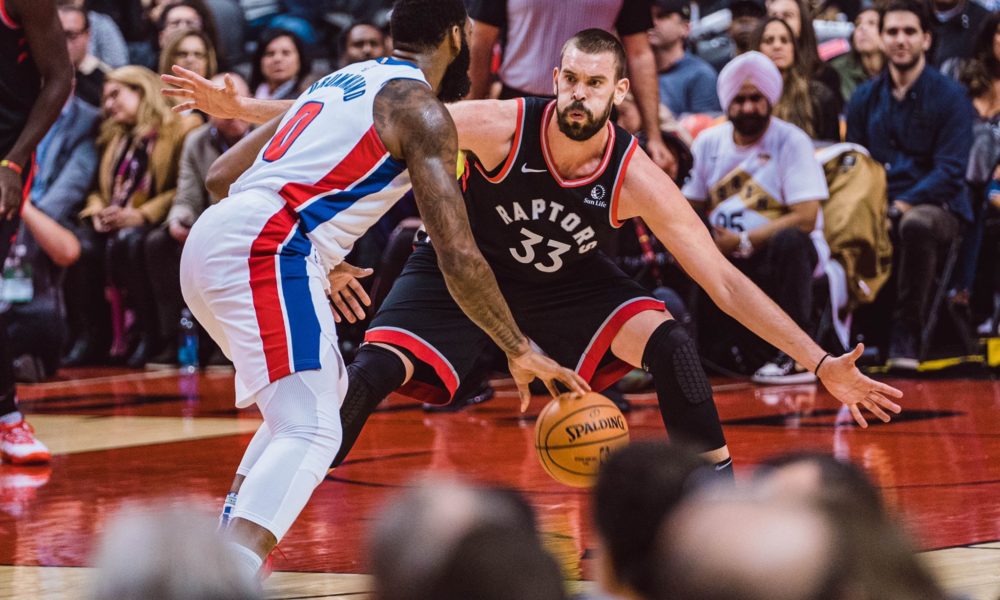Woof, that rebounding.
Through four games, the Toronto Raptors have now given up 57 offensive rebounds, second-most in the NBA, and far more than last year’s 10.6 offensive rebounds per game allowed to opponents. Don’t be fooled by the mirage that Toronto leads the league in defensive rebounds per game; it’s been a problem. No Raptor is averaging a 20 percent defensive rebounding rate. Elite defensive rebounders, who solve that problem on their own, generally vacuum between 25-30 percent of defensive rebounds on their lonesome. Andre Drummond, for example, averaged 31.1 percent last year. Toronto’s centers have rebounded woefully, the Orlando Magic game excepted. Against Orlando, Toronto had four players with eight rebounds or more, and Fred VanVleet and Kyle Lowry combined for nine more. It was their best defensive rebounding game of the season. Gang rebounding can be a solution, and it’s good that the Raptors have a blueprint going forward.
Regardless of the relative rebounding trouble, the Raptors sit at 3-1 with far more positives than negatives. Let’s go through some of the other defining statistical themes of the early season, both positive and negative, explaining how Toronto has battled to its record.
Don’t trust the plus-minus
(But still pay attention)
Plus-minus is a difficult statistic. On one hand, it’s the rawest indication of a winning player; if a team outscores opponents when a certain player is on the floor, and loses when he isn’t, then that player must be pretty good. So far through the season, two of Toronto’s per game plus-minus leaders have been Fred VanVleet (+11.5) and OG Anunoby (+10.3). That makes inherent sense. Both have played brilliantly, and the Raptors have looked quite poor when they’re off the floor. Furthermore, they’re both starters and key reserves, VanVleet at point guard and Anunoby at power forward. That means that when they’re on the bench, Toronto has the bottom of its rotation in the game. Siakam (+8.5), on the other hand, has played at least as well as VanVleet or Anunoby, but the Raptors often still look competent when he’s on the bench, even beating the New Orleans Pelicans in overtime after Siakam fouled out. Anunoby, for example, has played most power forward minutes when Siakam has sat. It makes sense that VanVleet and Anunoby would boast higher plus-minuses so far.
But plus-minuses can also be deceiving. Look at Serge Ibaka and Marc Gasol. Ibaka has been better so far on the season. Scoring isn’t everything, but Ibaka is averaging 13.3 points on team-high efficiency, while Gasol is averaging a paltry 5.5 on team-low efficiency. Other than a breakout game for Gasol against Orlando, Ibaka is moving better, rebounding better, blocking far more shots, and he’s doing all of it in fewer minutes. Yet Gasol’s plus-minus of +10.8 is second-best among rotation players and dwarfs Ibaka’s -4.5. What gives?
With such a small handful of games in the books, statistical variance can explain much. Take, for example, shooting. When Gasol is on the floor, the Raptors 43.9 percent from deep. When he’s off the floor, that number plummets to 28.0 percent. Gasol’s presence can explain some difference — the Raptors were the league’s best 3-point shooting to end the 2018-19 regular season after they acquired Gasol — but not nearly so much. Especially because the 3-point attempt rate is almost the same whether Gasol plays or not. It helps that Gasol has played with starters, but not to the extent that the numbers show. Really, players are hitting shots when Gasol plays, and they aren’t when he isn’t, and that’s mostly due to the randomness of small minute totals. Ibaka’s plus-minus thus far is poor, but his game has been anything but.
Run, run, run
Thus far, the Raptors are running with as much gusto as the Rhinoceros Party’s Maxime Bernier. VanVleet, especially, has looked to push in every situation, even after some made baskets. 21.1 percent of Toronto’s plays have come on the break, which is the third-highest rate in the NBA. They’ve also combined vigor with success, scoring 1.27 points per possession in such situations, highest in the league.
Toronto has been led by three candidates, who also happen to be the team’s three best players. Kyle Lowry, VanVleet, and Pascal Siakam all rank in the top-15 in the league for most efficient scorers in transition. Lowry and VanVleet have done plenty of damage spotting up around the arc while running, and Siakam has finished around the hoop with ease. The three have had fantastic chemistry on the break, and it’s clear that starting two point guards has allowed Toronto to push the pace.
OG Anunoby, defensive stalwart
Anunoby has been Toronto’s best defensive player to start the season. Samson had a wonderfully detailed look at it earlier in the day, but the simple numbers show Anunoby averaging 1.5 steals and 2.3 blocks per game. He’s been elite whether around the perimeter or in the paint, doing everything from locking up Jrue Holiday to rejecting Thad Young at the rim.
But Anunoby has been alone as an elite stopper. Toronto’s defense has been lax, although the performances against Chicago and Orlando were much better; progress is good. Still, they’ve had some great stands but given up offensive boards, or they’ve had sloppy mistakes that have allowed easy baskets.
What’s fascinating about Toronto’s defensive performance is that, despite the warts, the team has a defensive rating of 96.7, third-best in the league. There’s a disconnect between Toronto’s overall performance, which has been solid, and some of the details that have been lacking.
Last year, Toronto hung its hat on forcing opponents into difficult choices at every turn. Sure, Kawhi Leonard and Danny Green were big components of that, but it takes a village. Toronto’s village hasn’t been humming at full economic force, even if Anunoby has filled plenty of gaps. While Siakam has dominated on offense, his defense has been less active and alert than expected. He’s seventh in the league in fouls per game, at 4.5, which is indicative of him vacillating between doing too much and too little. It’s difficult to expend full energy on both sides of the ball, especially in the regular season. Marc Gasol has also had one great defensive game, one good one, and two below-average outings. Despite the solid overall numbers, defense is an area where Toronto has room to improve. That’s a scary thought.
VanVleet around the rim
Fred VanVleet’s finishing was one of the main stories of Toronto’s overtime win against the Pelicans. It seemed at times like his body, his arms, and the ball were all flying at different directions, and yet the ball would somehow fly off the glass at the perfect angle. VanVleet played with some of the grace of a Siakam or Kyrie Irving, yet with his own added flair of brute force. He took 61 percent of his shots at the rim in Toronto’s season-opener, shooting 7-of-11 there.
His layups have taken a turn for the worse since that game. VanVleet turned his ankle late against the Pelicans, and though he returned, his north-south burst seemed diminished. He played more off-ball than on- to end the game, and though his shooting was a key variable in winning, his helter-skelter attack had vanished. In the two games to follow, VanVleet has attempted only 36 percent of his shots at the rim, shooting 4-of-14. He’s missed some makeable scoops and reverses, he’s created contact, and perhaps a few whistles have been missed, but the difference begs the question: Was VanVleet’s finishing against New Orleans lucky, has his finishing since been unlucky, or has the ankle turn really limited his ability? The answer probably lies in the middle of those three extremes, but injuries sapped VanVleet for much of last year. Toronto needs him too much for him to rest, but it would be disastrous if VanVleet spent another year fighting various injuries throughout the entire season.
Turnovers
Toronto has played with the lackadaisical looseness of a defending champion. They’ve earned that, and Toronto’s 20.3 turnovers per game, fourth-most in the league, are understandable. But many of the miscues have been unforced. Various Raptors have jumped without having a plan in mind, stepped out of bounds in the corner, shuffled a pivot foot, or altogether made mistakes of focus rather than of effort. Stanley Johnson has averaged 2.0 turnovers per game in only 4.9 minutes, as he’s struggled to fit into the offense. It hasn’t just been him. Siakam, Lowry and VanVleet have all committed three turnovers or more per game, as there have been some growing pains into their new, larger roles on the offense. Expect the turnover numbers from those three to decline as the season continues, but the supporting cast must do a better job minimizing their own miscues.
We knew the Raptors would be good heading into the season. How good was a matter of degree. But if the Raptors can improve on some deficiencies — turnovers are an easy candidate, while defensive rebounding will wax and wane throughout the year — and retain their specific improvements already displayed throughout the year, then the Raptors will be fantastic. They’re already 3-1, with the league’s third-best net rating, at +8.8. The Raptors may not maintain that pace all year, but don’t expect them to fall too far off of it, either.



